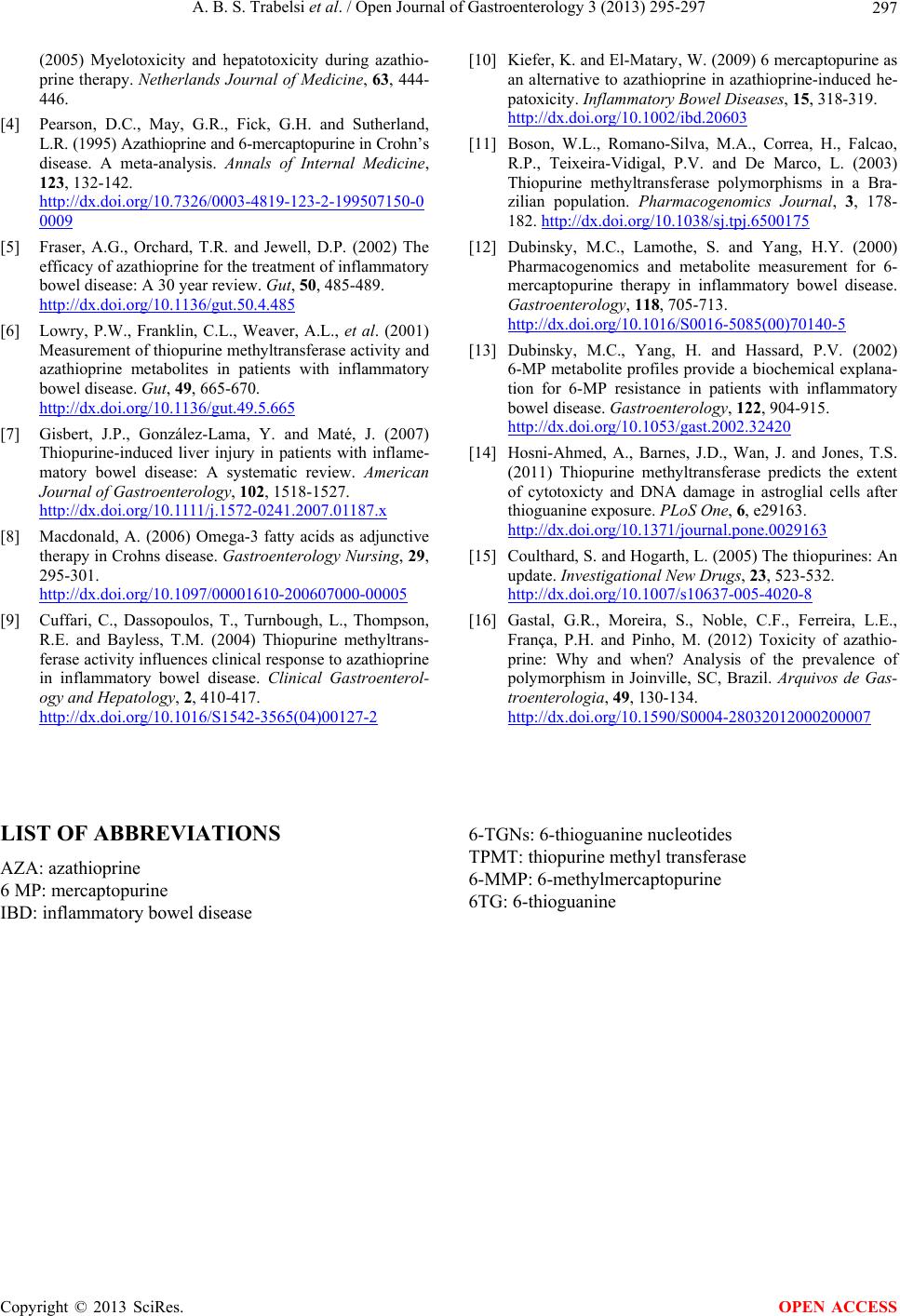
A. B. S. Trabelsi et al. / Open Journal of Gastroenterology 3 (2013) 295-297
Copyright © 2013 SciRes.
297
OPEN ACCESS
(2005) Myelotoxicity and hepatotoxicity during azathio-
prine therapy. Netherlands Journal of Medicine, 63, 444-
446.
[4] Pearson, D.C., May, G.R., Fick, G.H. and Sutherland,
L.R. (1995) Azathioprine and 6- mercaptopurine in Croh n’s
disease. A meta-analysis. Annals of Internal Medicine,
123, 132-142.
http://dx.doi.org/10.7326/0003-4819-123-2-199507150-0
0009
[5] Fraser, A.G., Orchard, T.R. and Jewell, D.P. (2002) The
efficacy of aza thiopri ne for the trea tment of i nflamma tory
bowel disease: A 30 year review. Gut, 50, 485-489.
http://dx.doi.org/10.1136/gut.50.4.485
[6] Lowry, P.W., Franklin, C.L., Weaver, A.L., et al. (2001)
Measurement of thiopurine methyltransferase activity and
azathioprine metabolites in patients with inflammatory
bowel disease. Gut, 49, 665-670.
http://dx.doi.org/10.1136/gut.49.5.665
[7] Gisbert, J.P., González-Lama, Y. and Maté, J. (2007)
Thiopurine-induced liver injury in patients with inflame-
matory bowel disease: A systematic review. American
Journal of Gastroenterology, 102, 1518-1527.
http://dx.doi.or g/10.1111/j.1572-0241.2007.01187.x
[8] Macdonald, A. (2006) Omega-3 fatty acids as adjunctive
therapy in Crohns disease. Gastroenterology Nursing, 29,
295-301.
http://dx.doi.org/10.1097/00001610-200607000-00005
[9] Cuffari, C., Dassopoulos, T., Turnbough, L., Thompson,
R.E. and Bayless, T.M. (2004) Thiopurine methyltrans-
ferase activity influences clinical response to azathioprine
in inflammatory bowel disease. Clinical Gastroenterol-
ogy and Hepatology, 2, 410-417.
http://dx.doi.org/10.1016/S1542-3565(04)00127-2
[10] Kiefer, K. and El-Matary, W. (2009) 6 mercaptopurine as
an alternative to azathioprine in azathioprine-induced he-
patoxicity. Inflammatory Bowel Diseases, 15, 318-319.
http://dx.doi.org/10.1002/ibd.20603
[11] Boson, W.L., Romano-Silva, M.A., Correa, H., Falcao,
R.P., Teixeira-Vidigal, P.V. and De Marco, L. (2003)
Thiopurine methyltransferase polymorphisms in a Bra-
zilian population. Pharmacogenomics Journal, 3, 178-
182. http://dx.doi.org/10.1038/sj.tpj.6500175
[12] Dubinsky, M.C., Lamothe, S. and Yang, H.Y. (2000)
Pharmacogenomics and metabolite measurement for 6-
mercaptopurine therapy in inflammatory bowel disease.
Gastroenterology, 118, 705-713.
http://dx.doi.org/10.1016/S0016-5085(00)70140-5
[13] Dubinsky, M.C., Yang, H. and Hassard, P.V. (2002)
6-MP metabolite profiles provide a biochemical explana-
tion for 6-MP resistance in patients with inflammatory
bowel disease. Gastroenterology, 122, 904-915.
http://dx.doi.org/10.1053/gast.2002.32420
[14] Hosni-Ahmed, A., Barnes, J.D., Wan, J. and Jones, T.S.
(2011) Thiopurine methyltransferase predicts the extent
of cytotoxicty and DNA damage in astroglial cells after
thioguanine exposure. PLoS One, 6, e29163.
http://dx.doi.org/10.1371/journal.pone.0029163
[15] Coulthard, S. and Hogarth, L. (2005) The thiopurines: An
update. Investigational New Drugs, 23, 523-532.
http://dx.doi.org/10.1007/s10637-005-4020-8
[16] Gastal, G.R., Moreira, S., Noble, C.F., Ferreira, L.E.,
França, P.H. and Pinho, M. (2012) Toxicity of azathio-
prine: Why and when? Analysis of the prevalence of
polymorphism in Joinville, SC, Brazil. Arquivos de Gas-
troenterologia, 49, 130-134.
http://dx.doi.org/10.1590/S0004-28032012000200007
LIST OF ABBREVIATIONS
AZA: azathioprine
6 MP: mercaptopurine
IBD: inflammatory bowel disease
6-TGNs: 6-thioguanine nucleotides
TPMT: thiopurine methyl transferase
6-MMP: 6-methylmercapt opurine
6TG: 6-thioguanine